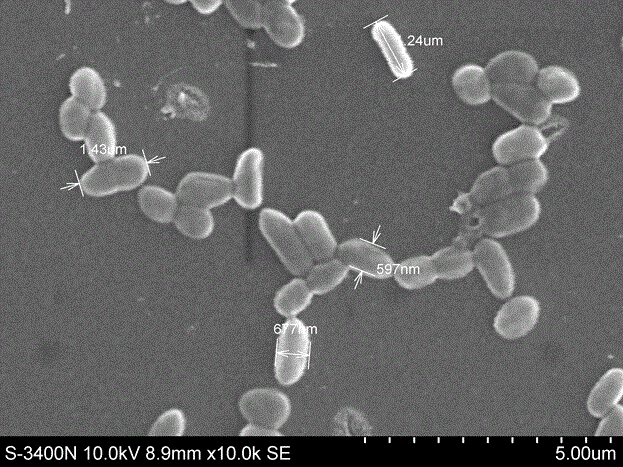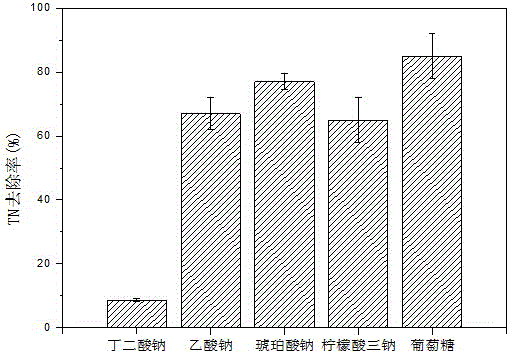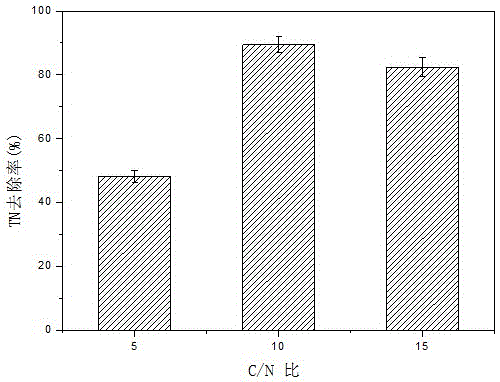Enterobacter cloacae and application thereof
A technology of Enterobacter cloacae, cgmccno.10348, applied in the field of environmental microorganisms, can solve the problems that the research on aerobic denitrifying bacteria is not yet perfect, the total nitrogen removal rate is less than 50%, and achieve good organic carbon removal capacity and extreme tolerance good effect
- Summary
- Abstract
- Description
- Claims
- Application Information
AI Technical Summary
Problems solved by technology
Method used
Image
Examples
Embodiment 1
[0026] 1. Screening of aerobic denitrification strains.
[0027] The activated sludge used in the present invention comes from Chongqing Jiguanshi Wastewater Treatment Plant A 2 / O process secondary sedimentation tank, the aerobic denitrification strains are screened by plate streak method, the liquid culture condition is 30~35℃, the shaker speed is 90~120rpm; the solid plate culture condition is the biochemical incubator temperature 30~35 ℃, specifically follow the steps below:
[0028] 1) Inoculate 1 mL of the sludge taken from the secondary sedimentation tank of the sewage treatment plant into the beef extract peptone liquid medium for enrichment and culture for 24 to 72 hours, and then take 1 mL of the above-mentioned culture solution for gradient dilution, and then separate the different gradients of the diluted culture solution Inoculate into the test tube of liquid medium Ⅰ to form several groups of culture solution, aerobic culture for 24~72h;
[0029] 2) Determine the pH va...
Embodiment 2
[0048] The effect of Enterobacter cloacae HNR on the removal of TN under different carbon source conditions was tested.
[0049] In NO 3 - -N is the only nitrogen source (the initial concentration is 100mg / L), the C / N ratio (carbon to nitrogen ratio) is 10, the pH is 7, and the temperature is 30°C under aerobic conditions, sodium acetate and succinic acid are selected respectively Sodium, glucose, trisodium citrate, and sodium succinate are used as carbon sources, and enterobacter cloacae HNR is used for the reaction. The results show that the strain HNR can use a variety of carbon sources, especially glucose as the optimal carbon source for aerobic denitrification. When glucose is used as the carbon source, the TN removal rate can reach over 85%. See the result figure 2 .
Embodiment 3
[0051] The effect of Enterobacter cloacae HNR on TN removal under different C / N ratio conditions was tested.
[0052] In NO 3 - -N is the only nitrogen source (the initial concentration is 100mg / L), glucose is the carbon source, pH is 7, and the temperature is 30℃. Under aerobic conditions, the effects of Enterobacter cloacae HNR on TN at different C / N ratios The removal effect. The results showed that strain HNR had better TN removal effect when the C / N ratio was 10-15. When the C / N ratio is 10, the TN removal rate can reach about 90%. See the result image 3 .
PUM
| Property | Measurement | Unit |
|---|---|---|
| diameter | aaaaa | aaaaa |
Abstract
Description
Claims
Application Information
 Login to View More
Login to View More - R&D
- Intellectual Property
- Life Sciences
- Materials
- Tech Scout
- Unparalleled Data Quality
- Higher Quality Content
- 60% Fewer Hallucinations
Browse by: Latest US Patents, China's latest patents, Technical Efficacy Thesaurus, Application Domain, Technology Topic, Popular Technical Reports.
© 2025 PatSnap. All rights reserved.Legal|Privacy policy|Modern Slavery Act Transparency Statement|Sitemap|About US| Contact US: help@patsnap.com



